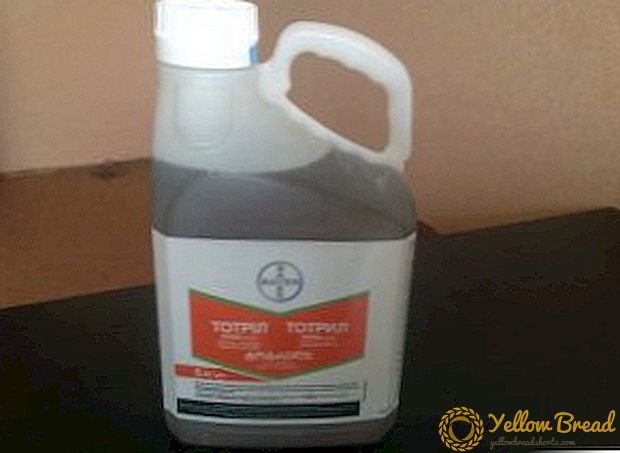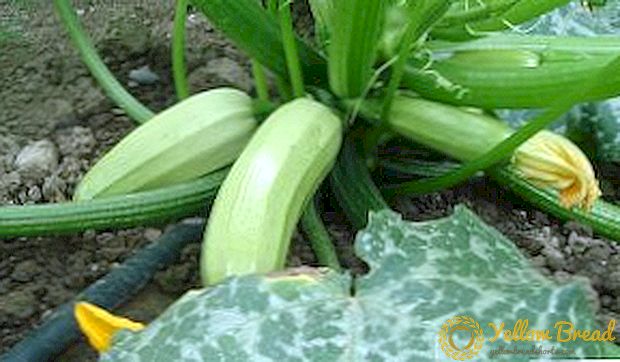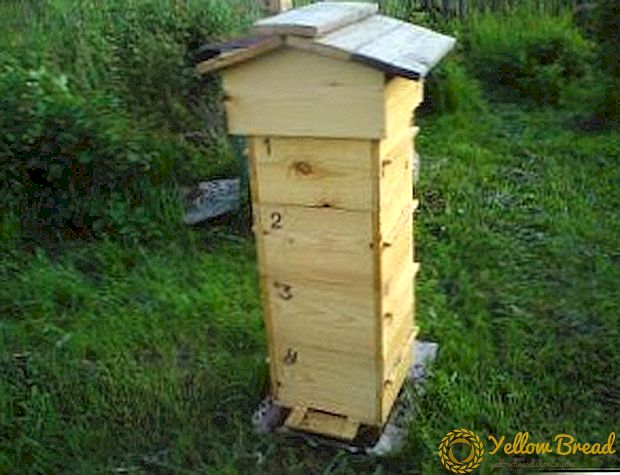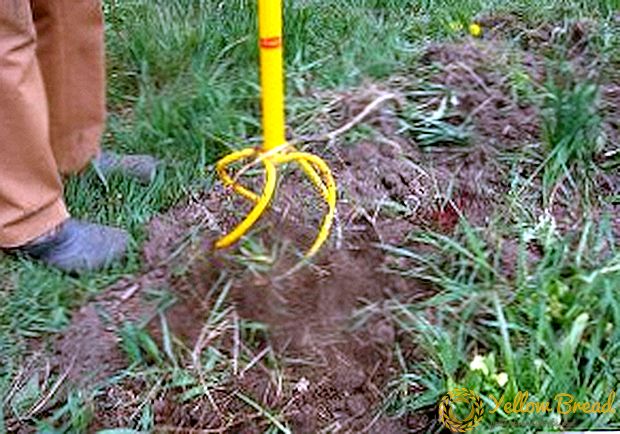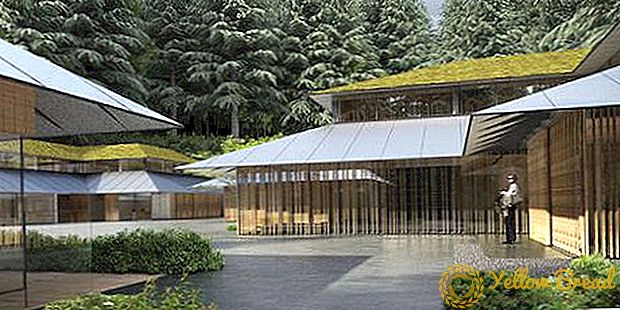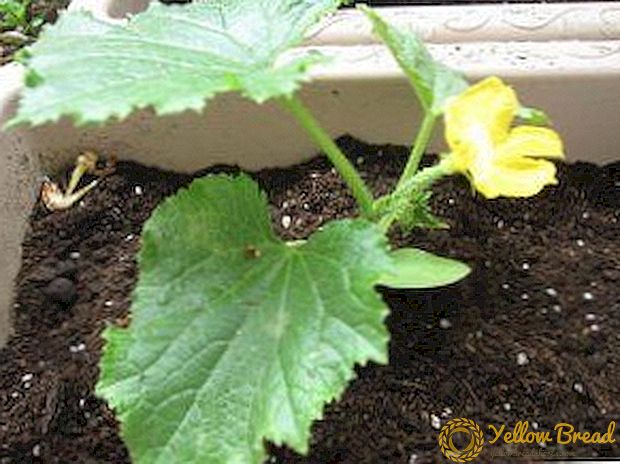 Winter wheat has been grown on the fields of the entire planet for a very long time.
Winter wheat has been grown on the fields of the entire planet for a very long time.
Winter wheat is an annual grass that lands in the ground from the end of summer to autumn, sprouts up to the first frost and survives the winter. After the end of the cold weather, the development of plants continues, and until the maturity of winter wheat reaches much faster than spring.
- Sort "Shestopalovka"
- Sort "Antonovka"
- Grade "Podolyanka"
- Sort "Favorite"
- Sort "Kuyalnik"
- Variety "Natalka"
- Variety "Odessa 267"
- Variety "Kherson bezostaya"
- Sort "Solokha"
Sort "Shestopalovka"
 The product of private breeding, created in 2007. It belongs to the variety of Lyutescens, that is, it is a variety of common wheat. This variety of winter crop of universal purpose is grown in the territory of Polesia, Forest-Steppe and Steppe. The plant itself reaches a height of 86 - 90 cm.The whole period of ripening takes 280 - 285 days.
The product of private breeding, created in 2007. It belongs to the variety of Lyutescens, that is, it is a variety of common wheat. This variety of winter crop of universal purpose is grown in the territory of Polesia, Forest-Steppe and Steppe. The plant itself reaches a height of 86 - 90 cm.The whole period of ripening takes 280 - 285 days.
Spikelets of wheat "Shestopalovka" are cylindrical in shape, loose in structure, painted in the color of yellow straw. The seeds are large, red, 1000 grains weigh 42.6 - 44.1 g.
This variety is very resistant to bad weather, that is, to severe frosts and drought. Plants calmly survive the winter, the grains in the spikelet do not germinate and do not fall out. Also bread resistant to lodging and diseases. From 1 hectare of the field goes 7 - 8.5 tons of grain. 1100 - 1180 cm3 of bread will be produced out of 100 g of flour obtained from the grain of this sort. Shestopalovsky grain contains a lot of fiber (about 30%) and protein (about 14%).
Sort "Antonovka"
 Variety of Ukrainian origin, bred in 2008. Designed for cultivation in the Steppe and Forest-Steppe. The variety is characterized by intensive growth, is widely used on various agricultural backgrounds. The growing season takes 280 - 285 days, so this wheat is considered mid-season.
Variety of Ukrainian origin, bred in 2008. Designed for cultivation in the Steppe and Forest-Steppe. The variety is characterized by intensive growth, is widely used on various agricultural backgrounds. The growing season takes 280 - 285 days, so this wheat is considered mid-season.
The plants are medium strong (92 - 96 cm), grow quite densely (610-830 plants per 1 square meter), and therefore it comes out to get a lot of harvest from the field. Spikelets are large (9–11 cm), with a large number of grain, cylindrical, with an average density (there are 20–22 spikelets per 10 cm of stem). Color spikelet - white, pubescence is absent.
The grain is large, red, egg-shaped, 1000 grains weigh 36.2 - 44.4 g.
 A distinctive feature of the variety is immunity to a set of phyto-diseases, that is, rust, rot and septoria do not damage this wheat. Also, the stems do not lie down, survive the winter and frost well, do not fear the lack of moisture and heat.
A distinctive feature of the variety is immunity to a set of phyto-diseases, that is, rust, rot and septoria do not damage this wheat. Also, the stems do not lie down, survive the winter and frost well, do not fear the lack of moisture and heat.
Grain is obtained very high quality, protein contains from 12 to 13%, and fiber - from 28 to 33%. It is advisable to provide wheat "Antonovka" high soil fertility or drop seeds on rich grounds. The amount of crop that can be obtained from 1 ha of field is 48.6-87.5 centners.
Grade "Podolyanka"
 Mid-season variety bred in Ukraine. Refers to varieties of soft wheat. It was approved in 2003. The variety is very high-yielding, used in many directions. The ability to regenerate in plants of this variety is excellent.
Mid-season variety bred in Ukraine. Refers to varieties of soft wheat. It was approved in 2003. The variety is very high-yielding, used in many directions. The ability to regenerate in plants of this variety is excellent.
Wheat "Podolyanka" germinates very quickly, gaining vegetative mass, and the entire growth period takes 305 - 310 days. The stem of the plant, along with the ear, reaches 95 - 99 cm in height, and the bush is semi-upright. The spikelets of this wheat look like a cone, of medium density and length, white, awnless.The grains of this wheat are red, egg-shaped, large in size. 1000 grains weigh 43.6 - 45.8 g. For this wheat, special agrotechnology is not needed, since the highly fertile soil is not needed for the variety Podolyanka. Neither drought nor frost harm the bushes.
 The stems do not lodge, the grains from the spikelets do not crumble, and the plants in general almost do not suffer from diseases, even from powdery mildew and brown rust. Supplemental irrigation and fertilizing will only help planting. The yield is about 60 kg / ha. Fiber in this variety of wheat is very much - from 32 to 36%.
The stems do not lodge, the grains from the spikelets do not crumble, and the plants in general almost do not suffer from diseases, even from powdery mildew and brown rust. Supplemental irrigation and fertilizing will only help planting. The yield is about 60 kg / ha. Fiber in this variety of wheat is very much - from 32 to 36%.
Sort "Favorite"
 "Favorite" - is a representative of the elite varieties, refers to the soft wheat. Most often, this variety is grown in an intensive way. It will be great to grow on the territory of the Forest-Steppe, Steppe and Polesia. "Favorite" is considered middle-ripened variety, crops of which are medium in height.
"Favorite" - is a representative of the elite varieties, refers to the soft wheat. Most often, this variety is grown in an intensive way. It will be great to grow on the territory of the Forest-Steppe, Steppe and Polesia. "Favorite" is considered middle-ripened variety, crops of which are medium in height.
Bushes grow strongly enough, 1000 seeds weigh 38-43 g. The vegetative period reaches 283 - 287 days. This variety is considered particularly valuable due to its quality characteristics. Resistance to frost is extremely strong, but drought resistance is not very good.
Also, this wheat is tolerant to a variety of diseases.The stems of these plants are very strong, they do not break under the action of strong winds even with a stem length of 96 - 105 cm. There is a lot of fiber in these ovate, large, red grains - 31-32%. The yield of this variety is high - 96-107 centners per hectare.
Sort "Kuyalnik"
 Erythrospermum group variety, bred by Ukrainian breeders. Designed for cultivation in the Steppe and Forest-Steppe. The plants of this variety of wheat have short stems, and the growth rate is very high. Stems of medium thickness, strong.
Erythrospermum group variety, bred by Ukrainian breeders. Designed for cultivation in the Steppe and Forest-Steppe. The plants of this variety of wheat have short stems, and the growth rate is very high. Stems of medium thickness, strong.
Spike spindle-shaped, medium length, low density, typical yellow color. Grains of this wheat are egg-shaped, medium-sized, 1000 units weighing 40 - 42 g. A maximum of 100 c / ha of yield can be obtained from this variety.
Grain varieties "Kuyalnik" is very high quality, as this variety has received its characteristics from the "parents" - varieties Olivia and Odessa red-hairs, and these varieties are considered the best among all varieties of winter wheat. “Kuyalnik” can withstand even very severe frosts, that is, it is not worth worrying about landing during winter. Also, the seedlings will calmly survive the lack of moisture and high temperatures, the stems do not lodge, and the grains do not germinate and crumble.
Diseases also have little effect on plants.
Variety "Natalka"
 It is considered soft wheat. It was bred for cultivation on the steppe, forest-steppe soils and soils of Polesye. The growing season takes 280 - 287 days. The representative of the species Eritrospermum. Grain is used to make flour and bread. The plants are tall (95 - 102 cm), semi-upright. spikelets elongated, spinous, medium dense, slightly resemble a pyramid, white or light yellow in color, with a faint brilliant bloom.
It is considered soft wheat. It was bred for cultivation on the steppe, forest-steppe soils and soils of Polesye. The growing season takes 280 - 287 days. The representative of the species Eritrospermum. Grain is used to make flour and bread. The plants are tall (95 - 102 cm), semi-upright. spikelets elongated, spinous, medium dense, slightly resemble a pyramid, white or light yellow in color, with a faint brilliant bloom.
The seeds are red, large, 1000 units weigh 42.6 - 47.8 g. The amount of fiber in the product reaches 31.7 - 33.9%. Because of the average resistance to diseases and pests, planting this variety of wheat needs 2-3 times a day. The plants tolerate the winter well, the dry period, they do not lodge, they are not subject to powdery mildew, the grain in the spikelet does not germinate. The planting will be greatly affected by the application of fertilizers of different composition.
Variety "Odessa 267"
 Ukrainian wheat, which was bred in 1997. It belongs to the variety Eritrospermum. Suitable for playing on the soils of the Forest-Steppe and Steppe. Bushes high (110 - 120 cm), semi-erect, with green leaves.
Ukrainian wheat, which was bred in 1997. It belongs to the variety Eritrospermum. Suitable for playing on the soils of the Forest-Steppe and Steppe. Bushes high (110 - 120 cm), semi-erect, with green leaves.
Spikelets and stems are the same in color - white.The spindle-shaped spindle-shaped, it is rather oblong (9–10 cm), of increased density — 23 spikelets per 10 cm of stem. Grains are egg-like, reddish, large-sized, 1000 units weigh 38 - 42.8 g. Spits of this wheat are no longer than spikelets, rigid, diverging to the sides. Resistance to lodging and diseases is slightly above average, but frost and drought will not be able to harm planting at all.
Grains do not germinate in spikelets. The yield per hectare is 57.6 centners of wheat grains.
Variety "Kherson bezostaya"
 Early variety from the list of Lyutescenses of Ukrainian origin. It was registered in 2002. It can grow in conditions of Polesia, Steppe and Forest-Steppe. The spikelets are white, cylinder-like, of medium length (7.5–8.5 cm), of average density (17–21 spikelets per 10 cm of stem). To the top, they are slightly pointed. Grains of a red shade, egg-shaped, 1000 pieces will weigh 40 - 52 g.
Early variety from the list of Lyutescenses of Ukrainian origin. It was registered in 2002. It can grow in conditions of Polesia, Steppe and Forest-Steppe. The spikelets are white, cylinder-like, of medium length (7.5–8.5 cm), of average density (17–21 spikelets per 10 cm of stem). To the top, they are slightly pointed. Grains of a red shade, egg-shaped, 1000 pieces will weigh 40 - 52 g.
The stalk of this variety of wheat is short, as for this crop - 80 - 90 cm. Therefore, this type of wheat has an extremely high resistance to lodging. Protection against diseases in "Kherson bezostoy" wheat innate and very strong. Also this wheat has a pronounced resistance to cold. The yield is 72.3 c / ha.
The grain is very high quality and energy rich.
Sort "Solokha"
 Middle-early variety with a ripening period of 274 - 278 days. This Ukrainian wheat is intended for cultivation in conditions of the Steppe and Forest-Steppe. Refers to a variety of soft wheat. It has a universal purpose. Plants grow up to 1 m in height, grains are large, 1000 pieces weigh about 47 g.
Middle-early variety with a ripening period of 274 - 278 days. This Ukrainian wheat is intended for cultivation in conditions of the Steppe and Forest-Steppe. Refers to a variety of soft wheat. It has a universal purpose. Plants grow up to 1 m in height, grains are large, 1000 pieces weigh about 47 g.
Diseases can slightly spoil the condition of wheat, but at the same time neither frost nor heat have any effect on its condition. Grains do not crumble and do not germinate, and the stems do not lie under the winds. From 1 hectare of the field you can get about 8 - 9 tons of crop "Solokha" will grow even better if the soil is fertile.
In order to grow wheat, you do not need to spend too much effort on this procedure. But at the same time, it will be much easier to grow winter wheat, since in this case in early spring you will have to wait only a little for the moment when the spikelets appear and mature.

